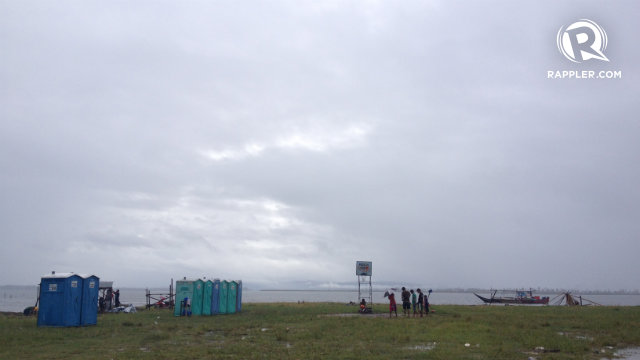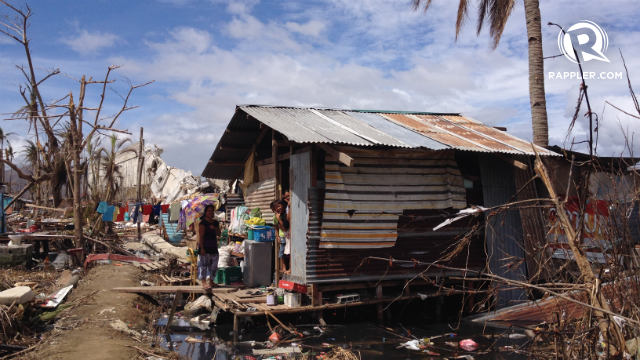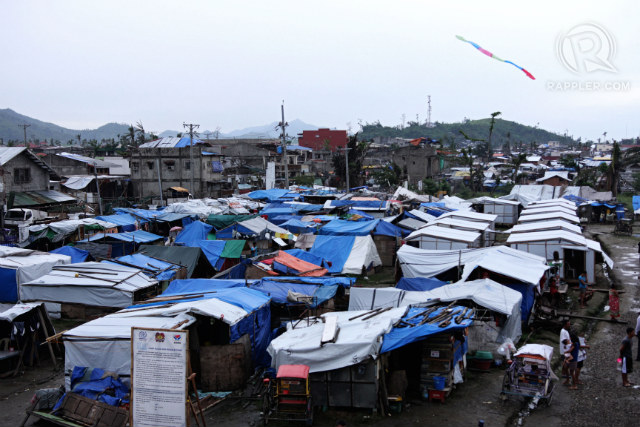SUMMARY
This is AI generated summarization, which may have errors. For context, always refer to the full article.

MANILA, Philippines – Let me tell you a story.
Her name is Lucy Dacoycoy. She is 60-year-old and lives, or lived, in Garangay 60-A in Tacloban, Leyte. On November 8, 2013, Lucy, along with her grandchildren and 2 children, were huddled inside the Tacloban City astrodome, hoping Typhoon Yolanda (Haiyan), would pass over their city sooner. But the wind was strong, and water started to gush into the astrodome, built precariously close to the sea. Lucy saw neighbors, friends, and strangers die that day.
Lucy’s son-in-law didn’t think Yolanda was as bad as local officials said. He needed to make sure their home and their livelihood would be unharmed. He stayed in their house, even when the wind threatened to tear it apart and the sea wanted to swallow them whole. In a nearby town, Lucy’s son Eduardo was in jail, safe from the storm, or at least she hoped.
It is November 22, 2013, two weeks after Yolanda. It was a storm that turned out to be one of the strongest to make landfall in the history of the earth, wreaking havoc on Tacloban and nearby provinces. More than 6,000 people died because of Yolanda, at least according to the government’s official tally. Lucy’s son-in-law and Eduardo’s girlfriend would not survive Yolanda, their names penned into the official list of the dead and missing.
When we spoke to Lucy that Friday, she didn’t know how Eduardo was doing, or if Eduardo was alive at all. We interviewed Lucy, stayed a little longer for small talk after, and said our goodbyes. She wondered if we could find a way to reach Eduardo – and their cellphones were washed away by the storm, and nobody had the resources to visit her son in jail. I walked away, not really promising anything, but hoping to a higher being out there that Lucy and her family would somehow find a way to reach each other.
There are many other stories. In Tanauan, Joseph Lavita and his family are all safe and sound. Their house and business are in ruins, but everyone is alive – a little hungry, but alive. And there is 33-year-old Cherrylyn Elmansur, now living in a makeshift house in Barangay 83-C. She and her family hopped from one house to another as the storm surge enveloped their barangay. She doesn’t know how and why, but they all managed to stay alive.

These are the stories I wasn’t able to tell because – maybe there was no time, or maybe I wasn’t able to find the time, or maybe at that time, other stories needed to be told first. I tell them now because 100 days later, so many other stories wait to be told.
Journalists immerse themselves in calamities – the Zamboanga siege, the Bohol earthquake, Typhoon Yolanda – because we need to. It’s our job. It’s what we’re (hopefully) good at doing, and it’s what we have and want to do.
The word is immerse. Not wade, but jump in. Head first, if needed – safety precautions be dammed.
In many cases, it’s the best way to tell the story of how Joy lost her daughter, how Nieves waits for her son, how Michael hopes when there is no hope, or how Maria spent her birthday searching for her niece. You feel, you empathize, you journey with them.
In a land where the destruction, desperation, and political feuds did not make any sense, only the stories of the victims and survivors did. It was a story that you were part of, whether you liked it or not. So when the words would not flow, alarm bells went off.
This is the biggest nightmare of any writer, reporter, journalist, or storyteller: not being able to write, narrate, or recount things. At least, not in the way you want to. Or not when you want to.
It was a nightmare because of many reasons: deadlines to finish, bosses to appease, and egos (sometimes, your own) to stroke. It became infuriating because for most of the people you interviewed, for many of the people whose lives you disrupted just so you could talk to them, you were a ray of hope because finally, someone else would hear their story. Maybe, someone somewhere out there could give them the help they so desperately need.
So 100 days after, once the adrenaline rush from being on the field is all but a memory, when you’re back “home” doing the stories you’ve always been doing before their world turned upside down, you think more and more about the stories that weren’t told.

We tell stories because we hope people learn from them. How squabbling politicians aren’t making life any easier for survivors, how help took so long to come, how the living co-existed with the dead weeks after the storm, and how people were picking themselves up and telling their community: no, all is not lost. Yes, we still have the capacity to hope.
Yolanda is not just about the 300 km/h winds, the 6 meter storm surges, the P39 billion damage in infrastructure and agriculture, or even the 6,201 dead. It’s not about the numbers but the stories: how the 300 km/h winds made survivors feel like they were inside a washing machine, how the 6-meter storm surge took away one of Joy’s little girls, how each the damaged crops belong to a family now unsure of how to start again, or how each of the 6,201 dead should not have died.
It doesn’t make sense for someone who lives and breathes writing to run out of words. But in Tacloban, nothing made sense. The senselessness was something many of us accidentally brought back to Manila. It was enough to leave even the more “hardened” ones in the team without words.
Now that 100 days have passed since Yolanda, this is a reminder to me, to every story teller, and every story reader: there are so many more stories out there – of heartbreak, of survival, and hope, and (I know many of you are sick and tired of reading this) resilience.
And you need to keep on writing, reporting, telling, even if sometimes it doesn’t quite make sense because hopefully, one day it will. – Rappler.com
Add a comment
How does this make you feel?
There are no comments yet. Add your comment to start the conversation.